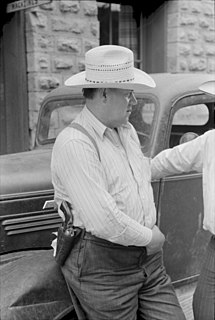
The counties or shires of Scotland are geographic subdivisions of Scotland established in the Middle Ages. Originally established for judicial purposes, from the 17th century they started to be used for local administration purposes as well. The areas used for judicial functions (sheriffdoms) came to diverge from the shires, which ceased to be used for local government purposes after 1975 under the Local Government (Scotland) Act 1973.

Argyll, sometimes anglicised as Argyllshire, is a historic county and registration county of western Scotland.
Thomas Adams is the name of:
A high sheriff is a ceremonial officer for each shrieval county of England and Wales and Northern Ireland or the chief sheriff of a number of paid sheriffs in U.S. states who outranks and commands the others in their court-related functions. In Canada, the High Sheriff provides administrative services to the supreme and provincial courts.

John Nisbet, Lord Dirleton was a Scottish judge.

Richard Weston, 1st Earl of Portland, KG, was Chancellor of the Exchequer and later Lord Treasurer of England under James I and Charles I, being one of the most influential figures in the early years of Charles I's Personal Rule and the architect of many of the policies that enabled him to rule without raising taxes through Parliament.
Sir Ralph Bovey, 1st Baronet, of Hillfields, Warwickshire, England was High Sheriff of Warwickshire and, later, Bedfordshire.

In the United States, a sheriff is an official in a county or independent city responsible for keeping the peace and enforcing the law. Unlike most officials in law enforcement in the United States, sheriffs are usually elected, although many states have state laws requiring that a person possess certain law enforcement qualifications before being able to run for the office. Elected sheriffs are accountable directly to the constitution of their state, the United States Constitution, statutes, and the citizens of their county.

Wonastow is a village in Monmouthshire, south east Wales. It is located 2 miles (3.2 km) south west of Monmouth.

Senegambia, also known in Dutch as Bovenkust, was the collective noun for the fortifications and trading posts owned by the Dutch West India Company (DWIC) in the region now known as Senegal. The main purpose of these trading posts was to obtain slaves in order to ship them to the Americas. The government of the territory was based on Gorée. In 1677, the Dutch lost this island to France. The next year, the French also conquered all DWIC trading posts on the Senegalese coast as well as the island of Arguin.
Sir Thomas Willys, 1st Baronet of Fen Ditton in Cambridgeshire, was a Member of Parliament for Cambridgeshire and Cambridge. He was also Sheriff of Cambridgeshire and Huntingdonshire.
Thomas Madryn was a Welsh politician who sat in the House of Commons in 1654. He fought in the Parliamentary army in the English Civil War.
Sir Nicholas Rainton was an English merchant who was Lord Mayor of London in 1632.
Ralph Freeman was an English merchant who was Lord Mayor of London in 1633.
Sir Thomas Denton was an English landowner and politician who sat in the House of Commons between 1604 and 1629.
The Baronetcy of Foljambe of Walton was created in the Baronetage of England on 24 July 1622 for Francis Foljambe of Walton Hall, Walton, near Chesterfield, Derbyshire, who was later Member of Parliament for Pontefract in 1626 and High Sheriff of Derbyshire in 1633.
The Sheriff of Madras was an apolitical titular position of authority bestowed for one year on a prominent citizen of Madras. The post was abolished in 1998.







